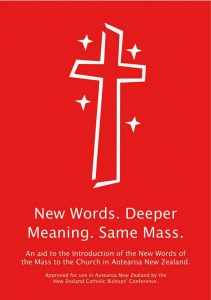View from the pews
One of the advantages of being editor of the Messenger is that I get to visit parishes all over NZ, and some in Australia, and have the privilege to join in the Sunday liturgies. During this period of familiarisation with parts of the new English translation it has been particularly interesting seeing how people cope with the new Ordinary of the Mass. In NZ we have had the red booklet New Words, Deeper Meaning, Same Mass, and in Australia the large card in the pews, so that the new words are available to the people.
Congregations have managed extremely well with the new words, whatever their feelings about them may have been.
In general, congregations that I have visited have managed extremely well with the new words, whatever their feelings about them may have been. In many parishes I sensed that the liturgy committees are right up with the project. Often all the responses are on power-point projected onto a large screen , along with the musical settings of the new chants. It seems to work better for people with their heads up looking at a screen, than looking down into a book. Sometimes, to my amazement, I noticed a primary school aged child operating the laptop controlling the whole liturgy.
Most of the changes in the Ordinary of the Mass are minor so that old hands like me can be tripped up. To rely on memory risks launching into old lines and leading others astray. One experienced pastor remarked to me that he doubts whether most of his congregation has ever “greatly sinned” so why should they have to recite it at church? I hear people mispronouncing “griev-i-ous” as they used to in the 1950s but that’s a trifle.
Recently I have sensed that the congregations now know the dialogues by heart, and nearly the same for the Gloria and Creed. This is the stage when the act of worship becomes instinctive and internalised. I still need one eye on the text in case I roll forward with the old phrases.
In the main I would conclude that the idea to introduce the Ordinary of the Mass first was an inspired one because it provides a familiar setting for the full text of the new translation to be situated.
I have observed that where the celebrant is confident, the liturgy flows. With encouragement from the sanctuary the congregation follows. One parish I visited had a newly-ordained celebrant who knew all the priest parts by heart, and the choir had mastered all the new musical settings, so the result was prayerful liturgy that seemed effortless. I was sure that this did not happen by chance. The ministers had prepared well, and the pastor made sure all the parts fitted together well. It was a joy to behold and take part in.
 In one of the NZ Dioceses, the Bishop surveyed his people on their views on parts of the new translation thus far used. The result was a considerable level of unhappiness. The Bishop has referred these views on to the CDW in Rome. Obviously this Bishop would have preferred to make this consultation much earlier in the process. The process by which this text has come to us has been controversial in the English-speaking Church, but it is a separate issue to the implementation of an approved text
In one of the NZ Dioceses, the Bishop surveyed his people on their views on parts of the new translation thus far used. The result was a considerable level of unhappiness. The Bishop has referred these views on to the CDW in Rome. Obviously this Bishop would have preferred to make this consultation much earlier in the process. The process by which this text has come to us has been controversial in the English-speaking Church, but it is a separate issue to the implementation of an approved text
At the time of writing the full new text with the Prefaces and Eucharistic prayers has not arrived so I have not experienced it. The roll-out of the full new translation at Advent will afford a chance for all to savour it. Once it is in place and mandatory, it will stand or fall on its own merits, and the process by which it came to us will be largely irrelevant. Now is the time to worship.

 Entries(RSS)
Entries(RSS)